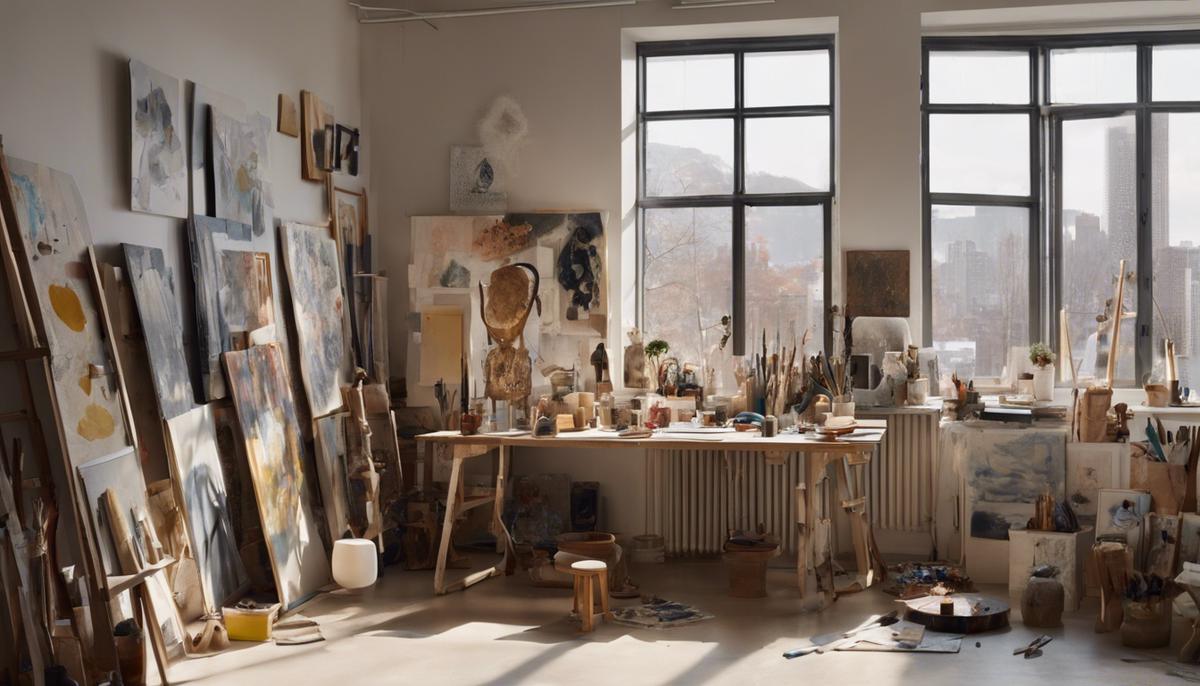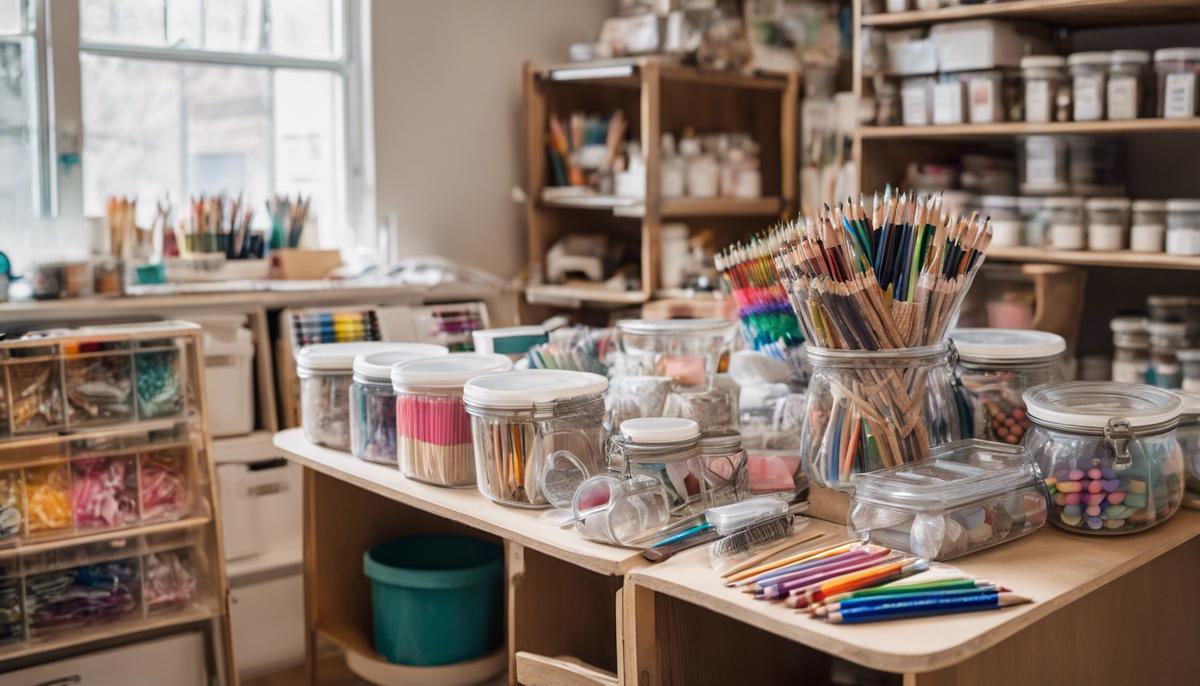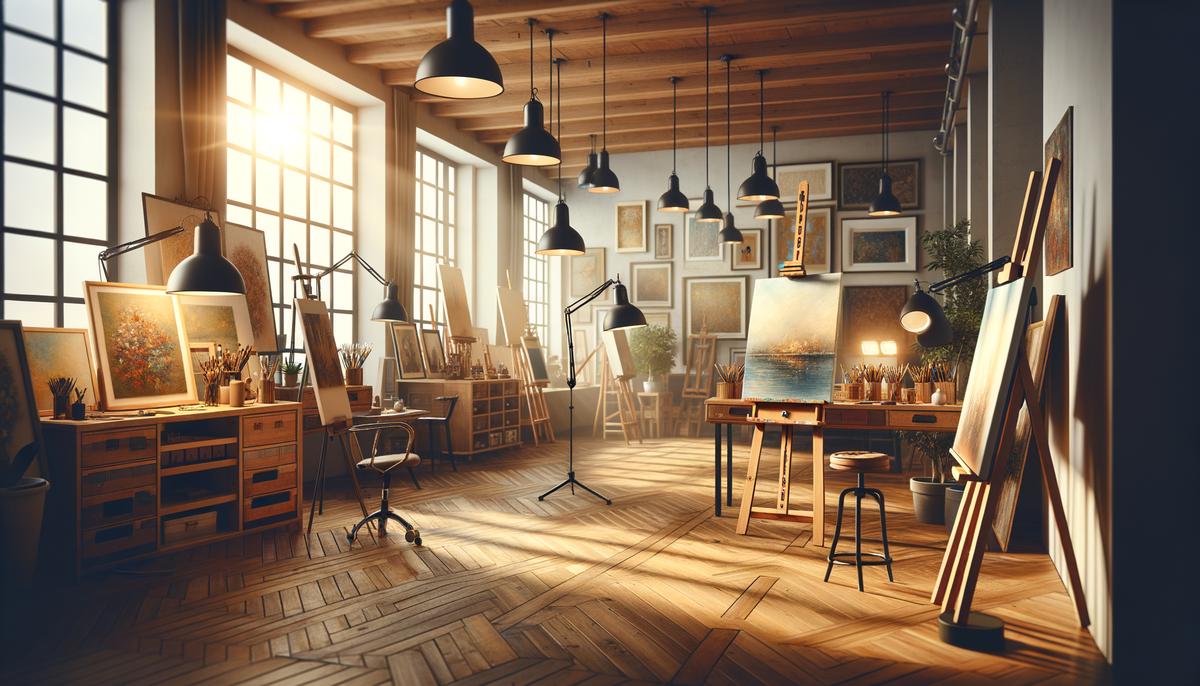Choosing the Right Space
Choosing the right space for your at-home art studio is about balancing practicality with inspiration. For many, a spare room presents an ideal setting, allowing ample room to create and sometimes make a bit of a mess.
For those with tighter living quarters, a corner of a living room or an underutilized dining area can transform into a productive art nook. Maximize the space you have with smart storage solutions and furniture that can be easily moved or tucked away. A foldable easel, expandable worktable, or a set of drawers on casters can make even compact spaces art-friendly.
Consider the garden shed or garage as potential studio locations. These out-of-the-box spaces often provide the isolation necessary for deep focus and minimal interruptions. If you're working with materials that require ventilation or produce noise, these external spaces could be your sanctuary.
Wherever your studio ends up, remember that natural light is an artist's best friend. A well-lit space reduces strain on your eyes and provides clarity and vibrancy to your works. If north light is an option, take advantage of that constant, indirect light coveted by artists. In its absence, a combination of daylight bulbs and adjustable lamps will provide a good substitute.
An art studio at home isn't just about where you can fit it but creating a spot where you feel free to explore and express your creativity. This might mean being surrounded by inspiring objects, art from others that you admire, or having a view that keeps your ideas flowing. Personal comfort plays a significant role as well; a space too cramped, too dark, or too cold might stifle your creative spirit.
Lastly, consider the practical aspects of your chosen spot. Is there a sink nearby for easy cleanup? Is the flooring prone to damage or easy to clean? Will you have to pack up your materials after each use? Your studio space should cater to the whole process, from inception to cleanup. Think ahead to what a day in your studio looks like and tailor your space to fit your artistic and practical needs.
As you evaluate the potential spots in your home, balancing aspirations with reality, remember that the right space is one that encourages you to create. Whether it's a quiet corner of your bedroom or an airy spot in your living room, it's about making it yours. Embrace the uniqueness of your home and let it inspire the uniqueness of your art.

Organising Supplies and Materials
Once your art studio space is established, the next crucial step is organizing your supplies and materials. It's about transforming your area into a creative oasis, where everything you need is at your fingertips, without the clutter that hinders creativity. Here's a practical guide to ensure your studio remains as efficiently arranged as it is visually inspiring.
First, consider shelves. Shelves are perfect for lining up your paint, canvases, and other bulky items. Make use of unused wall space by installing floating shelves. They're visually appealing and won't encroach on your precious floor space. Plus, they give your studio an open, airy feel, making it appear more spacious.
Pegboards are incredibly useful. Install one on your studio wall and hang everything from scissors and tape to brushes and rulers. The versatility of a pegboard allows you to rearrange hooks and shelves to suit your current project's needs, ensuring that tools are within reach but not in your way.
Jars and baskets are handier than you might think. Small items like pencils, erasers, and knick-knacks can quickly turn a tidy studio into a mess if not contained. Use clear jars for frequently used items so you can see what's inside without needing to search through multiple containers. Baskets can be used for larger, oddly shaped items that don't stack well, and they add a homely, rustic touch to your workspace.
Drawer organizers, typically used for cutlery or makeup, are perfect for separating smaller supplies and can be labeled for extra ease of access. Having everything neatly categorized means less time searching and more time creating.
Don't forget the power of labeling. Whether it's on the shelves, jars, baskets, or drawers, labels can save you time and prevent unnecessary frustration. You'll be surprised how much smoother your creative process flows when you're not constantly pausing to remember where you've put the pastels.
As you set up these systems, keep aesthetics in mind. Your workspace should be a source of inspiration, so choose storage solutions that speak to your artistic style. Maybe vintage crates for a rustic look or sleek, minimalistic boxes for a modern vibe. Whatever you decide, remember your studio is a reflection of you.
Consistently maintaining this organization system is key. Make a habit of returning items to their designated spots after use. It might take a bit of discipline initially, but it's worth it. A neat studio is not just pleasing to the eye; it's mentally uplifting and can significantly enhance your creative flow.
By following these practical steps, your studio will not only encourage creativity but will also manifest as a visual representation of your artistic identity. An organized studio means an organized mind, ready to embark on the next creative journey with enthusiasm and zero obstacles.

Lighting and Ambience Setting
Lighting up your art studio isn't just about seeing your canvas clearly—it's about sparking creativity and transforming your studio from a mere workroom into a haven of inspiration. Here's how to bathe your art space in the perfect blend of luminescence and ambiance, nurturing an environment where creativity flourishes.
First, embrace natural light not only for the benefit of your artwork but for your well-being too. Position your workspace near a window if possible. Daylight brings out the true colors in your palette, offering a fidelity artificial lights struggle to mimic. For overcast days or when dusk creeps in, having a mix of ceiling lights and adjustable lamps allows you to continue creating without straining your eyes. Consider daylight simulation bulbs that mimic the natural spectrum of outdoor light, ensuring the hues you select remain consistent no matter the time.
While overhead lighting ensures a well-lit room, task lighting is equally important. Adjustable desk or floor lamps with built-in dimmers can focus light exactly where you need it, be it a detailed sketch or a corner of your canvas awaiting your brush. The versatility of clip-on easel lights comes in handy as well, allowing for targeted illumination across different working stations.
Crafting an ambiance that inspires is also important. Personal touches can transform an ordinary space into your unique creative sanctuary. Perhaps a string of fairy lights draping softly above your workbench, casting a gentle glow, or a carefully selected lampshade diffusing warmth across your favorite sketches.
Don't overlook the power of color temperature in lighting. Warmer hues might comfort and envelop you in coziness, perfect for introspective art sessions. On the other hand, cooler tones sharpen focus and wake up the mind, suitable for tackling intricate designs or meeting deadlines.
Amidst these practical elements of lighting, creating a studio that resonates with you on a personal level is key. It could be a line of potted plants basking in the sunlight on your windowsill, each a silent cheerleader to your creative pursuits, or an ensemble of inspiring postcards and photos pinned up, their edges caught in the soft beam of an articulated lamp.
Your art studio's lighting and ambiance setting is more than brightness and shadow; it's an extension of yourself, meticulously crafted to foster creativity. Through the combination of natural light's authenticity with the versatility of artificial lighting, complemented by personal decorations that touch upon your essence, you have the power to create an atmosphere that invites inspiration. Remember, it's not solely what you see under the light but how what you see makes you feel within your illuminated art studio.

Creating an art studio at home is about fashioning a place that resonates with your artistic spirit, where every tool is within reach and every light cast enhances your work. The right space is one that encourages you to create, transforming everyday moments into moments of inspiration.

























